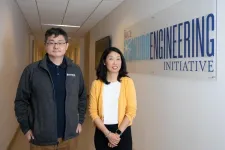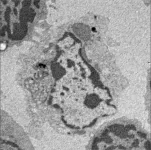(Press-News.org) Defects often limit the performance of devices such as light-emitting diodes (LEDs). The mechanisms by which defects annihilate charge carriers are well understood in materials that emit light at red or green wavelengths, but an explanation has been lacking for such loss in shorter-wavelength (blue or ultraviolet) emitters.
Researchers in the Department of Materials at UC Santa Barbara, however, recently uncovered the crucial role of the Auger-Meitner effect, a mechanism that allows an electron to lose energy by kicking another electron up to a higher-energy state.
“It is well known that defects or impurities — collectively referred to as ‘traps’ — reduce the efficiency of LEDs and other electronic devices,” said Materials Professor Chris Van de Walle, whose group performed the research.
The new methodology revealed that the trap-assisted Auger-Meitner effect can produce loss rates that are orders of magnitude greater than those caused by other previously considered mechanisms, thus resolving the puzzle of how defects affect the efficiency of blue or UV light emitters. The findings are published in the journal Physical Review Letters.
Observations of this phenomenon date back to the 1950s, when researchers at Bell Labs and General Electric observed its detrimental impact on transistors. Van de Walle explained that electrons can get trapped at defects and become unable to perform their intended role in the device, be it amplifying a charge in a transistor or emitting light by recombining it with a hole (an unoccupied lower-energy state) in an LED. The energy lost in this recombination process was assumed to be released in the form of phonons, i.e., lattice vibrations that heat up the device.
Van de Walle’s group had previously modeled this phonon-mediated process and found that it duly fitted the observed efficiency loss in LEDs that emit light in the red or green regions of the spectrum. However, for blue or ultraviolet LEDs the model failed; the larger amount of energy carried by the electrons at these shorter wavelengths simply cannot be dissipated in the form of phonons.
“This is where the Auger-Meitner process comes in,” explained Fangzhou Zhao, a postdoctoral researcher in Van de Walle’s group and the project’s lead researcher. The researchers found that, instead of releasing energy in the form of phonons, the electron transfers its energy to another electron that gets kicked up to a higher energy state. This process is often referred to as the Auger effect, after Pierre Auger, who reported it in 1923. However Lise Meitner — whose many accomplishments were never properly recognized during her lifetime — had already described the same phenomenon in 1922.
Experimental work in the group of UC Santa Barbara materials professor James Speck had suggested previously that trap-assisted Auger-Meitner processes could occur; however, based on measurements alone, it is difficult to rigorously distinguish between different recombination channels. Zhao and his co-researchers developed a first-principles methodology that, combined with cutting-edge computations, conclusively established the crucial role of the Auger-Meitner process. In the case of gallium nitride, the key material used in commercial LEDs, the results showed trap-assisted recombination rates that were more than a billion times greater than if only the phonon-mediated process had been considered. Clearly, not every trap will show such huge enhancements; but with the new methodology in hand, researchers can now accurately assess which defects or impurities are actually detrimental to the efficiency.
“The computational formalism is completely general and can be applied to any defect or impurity in semiconducting or insulating materials,” said Mark Turiansky, another postdoctoral researcher in Van de Walle’s group who was involved in the project. The researchers hope that these results will increase understanding of recombination mechanisms not only in semiconductor light emitters, but also in any wide-band-gap material in which defects limit efficiency.
The research was supported by the Department of Energy Office of Basic Energy Sciences and a Department of Defense Vannevar Bush Faculty Fellowship, which was awarded to Van de Walle in 2022. Zhao was the recipient of an Elings Prize Postdoctoral Fellowship. The computations were performed at the National Energy Research Scientific Computing Center (NERSC).
END
Uncovering the Auger-Meitner effect’s crucial role in electron energy loss
2023-08-07
ELSE PRESS RELEASES FROM THIS DATE:
Increased risk of dementia diagnosis, benzodiazepine exposure in seniors with anxiety
2023-08-07
ST. LOUIS - Research from Saint Louis University School of Medicine finds that among patients 65 and older, a diagnosis of anxiety was significantly associated with an increased risk of dementia diagnosis, and benzodiazepine exposure was associated with a 28% increased risk of dementia. However, when benzodiazepines were prescribed to patients with an anxiety disorder, there was no significant association between these medications and incident dementia.
The study, “Anxiety Disorders, Benzodiazepine Prescription ...
Paper addresses ethics of bioethics conference in Qatar
2023-08-07
The decision by a global bioethics association to hold its 2024 congress in Qatar, a nation with laws against LGBTQ+ people, provoked controversy, including objections from some of its own members.
The outcry motivated the organization’s president and colleagues to draft an ethics framework to guide future site selection. The framework, published today in The American Journal of Bioethics, might also help global organizations make decisions about ethically appropriate conference sites. [The paper is available in PDF by request.]
“Many organizations around the world are addressing these questions,” ...
Breakthrough polymer research promises to revolutionize recycling
2023-08-07
A team of researchers led by Brent Sumerlin, the George B. Butler Professor in the University of Florida Department of Chemistry, has made a breakthrough with the potential to transform how we recycle plastics. Their innovative approach to working with polymers has led them to develop a new method for recycling that promises to lower the energy requirement without sacrificing the quality of the plastic.
It’s no secret that the U.S. and the Earth at large have a pressing plastic problem. Despite a meteoric rise in usage over the past few decades, only about 10% of our plastic currently ends up getting recycled.
“Our work is a response ...
New study in JNCCN highlights rapid adoption of clinical research results into chemotherapy prescribing patterns
2023-08-07
PLYMOUTH MEETING, PA [August 7, 2023] — New research in the August 2023 issue of JNCCN—Journal of the National Comprehensive Cancer Network evaluates how an important analysis on local-regionally advanced colon cancer adjuvant chemotherapy impacted prescribing patterns. The IDEA collaboration included more than 12,000 patients with Stage III colon cancer across 6 randomized phase 3 trials in a planned pooled analysis, to determine how three or six months of post-surgery chemotherapy—either a combination of capecitabine/oxaliplatin (CAPOX) or fluorouracil/leucovorin/oxaliplatin ...
American Heart Association CEO again honored as elite nonprofit leader, health equity champion
2023-08-07
DALLAS, August 7, 2023 — Nancy Brown, chief executive officer of the American Heart Association, has again been recognized for elite leadership in the 26th annual listing of The NonProfit Times Power & Influence Top 50. For more than three decades, The NonProfit Times has been a leading trade publication providing news, information and insight into nonprofit management.
Brown, who is now appearing for the 8th time on this list, was recognized specifically for her leadership as a champion for equitable health. The NonProfit ...
Department of Energy announces $4.7 million for research on integrative computational tools for systems biology research
2023-08-07
WASHINGTON, D.C. - Today, the U.S. Department of Energy (DOE) announced $4.7 million in funding for five new research projects in computational biology. These projects will develop new software and analytical tools to manage the growing quantities of genomics and other data stemming from the study of microbes and other biological systems.
“The Biological and Environmental Research (BER) Genomic Science program is at the forefront of using genome-enabled approaches to identify the basic principles that drive biological systems underlying functional processes of organisms,” said Todd Anderson, DOE Acting Associate Director for BER. “To gain ...
Tiny, flexible spinal probe system could lead to better therapies
2023-08-07
HOUSTON – (Aug.7, 2023) – The spinal cord is harder to access and study than even the brain. The challenges posed by its mobility and anatomical structure have made understanding exactly how it functions difficult.
Rice University engineers will work with collaborators to optimize an array of nanoelectronic threads, or NETs ⎯ already used successfully for gathering high-fidelity, long-term data from neurons in the brain ⎯ for use in the spine, supported by a $6.25 million, four-year grant from the National Institutes of Health.
In addition to neuronal activity recordings, NET probes can provide tunable, localized stimulation of adjacent neurons. Rice ...
Advancing environmental justice research and student engagement in energy
2023-08-07
HOUSTON, Aug. 7, 2023 – The Baker Hughes Foundation announced a $100,000 grant to the University of Houston Energy Transition Institute (ETI) to support environmental justice research and workforce development programs.
The institute, which focuses on the creation and use of reliable, affordable, environmentally responsible energy for all through a just and equity-driven pathway, is looking forward to using the grant to amplify its mission.
“Thanks to the generous support of the Baker Hughes Foundation, the UH ...
Carbon dioxide – not water – triggers explosive basaltic volcanoes
2023-08-07
ITHACA, N.Y. – Geoscientists have long thought that water – along with shallow magma stored in Earth’s crust – drives volcanoes to erupt. Now, thanks to newly developed research tools at Cornell, scientists have learned that gaseous carbon dioxide can trigger explosive eruptions.
A new model suggests that basaltic volcanoes, typically located on the interior of tectonic plates, are fed by a deep magma within the mantle, stored about 20 to 30 kilometers below Earth’s surface.
The research, which offers a clearer picture of our planet’s deep internal dynamics and composition, with ...
Inside job: Finding exposes unexpected killer of immune cells lacking self marker
2023-08-07
Researchers at Kobe University discovered an entirely new and unexpected mechanism by which the immune system can get rid of cells lacking molecules that identify them as part of the self in mice. The finding, published in PNAS, has possible implications for cancer treatment.
The immune system comprises many types of cells that work together to fight off diseases. Two important types are dendritic cells and T cells. Dendritic cells are located in strategic positions throughout the body including the gut and skin, as well as in the lymph nodes, sample their environment and present small components derived from these samples on their ...


